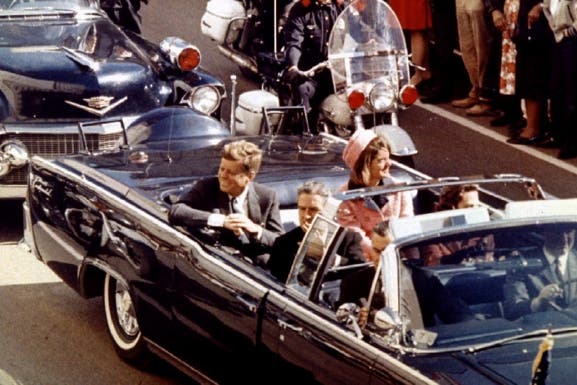

In October 2017, the National Archives released more than 2,800 previously classified records relating to the assassination of President John F. Kennedy. The documents sparked a feeding frenzy among historians and conspiracy theorists alike.
1) Of the documents that were originally set to be released, some 3,100 had never been seen by the public before. Though few experts expected the final batch of files to offer up a “smoking gun” proving Lee Harvey Oswald did not act alone in killing Kennedy in Dallas on November 22, 1963, the last batch of files were expected to provide more insight into exactly how much U.S. national security agencies knew about Oswald before the assassination, and how much information the CIA and FBI withheld from the official investigation into the assassination, which concluded in 1964.
Among the revelations to emerge from the files were CIA notes on an intercepted telephone call on September 28, 1963, from Lee Harvey Oswald to a KGB agent in Mexico City. There was also evidence that the FBI’s Dallas office received a threat on Oswald’s life on November 23, 1963, the night before Jack Ruby shot him, from a man saying he was a “member of a committee organized to kill Oswald.”
Watch the three-episode documentary event, Kennedy. Available to stream now.
2) Many of the most anticipated remaining files relate to a trip Oswald took to Mexico City in September 1963, just two months before he shot Kennedy. During his visit, Oswald went to the Cuban embassy and met with officials in his attempt to get a visa to travel to Cuba, and then on to the Soviet Union.
3) Many of the files originally set for release reportedly come from the CIA office in Mexico City, and may reveal whether U.S. operatives there knew of Oswald’s plan to kill Kennedy (which he reportedly talked openly about during his trip) and how much they may have withheld from CIA headquarters in Washington.
Gerald Posner, an expert on the Kennedy assassination and author of the book Cold Case, speculated that the revelations contained in the files might have proven embarrassing to some prominent figures: “There may be people who were informing to the CIA at the time who have moved on to careers in politics and business, and the revelation that they were informing will be embarrassing to them.”
Posner also believes the files may contain intriguing items unrelated to the assassination, including a handwritten letter from Jackie Kennedy about her husband’s funeral and a previously classified letter from J. Edgar Hoover.
The files also contain a transcript of a 1976 interview congressional investigators conducted with James Jesus Angleton, director of counterintelligence for the CIA in 1963. Angleton was the main conduit of information between the agency and the Warren Commission, which investigated the assassination.
A study suggests the 'grassy knoll' JFK assassination theory is bogus.
Four sitting U.S. presidents have been felled by gunfire. Each time, important reforms and a new political era followed.
Warren Commission: President Kennedy is assassinated The 46‑year‑old Kennedy was shot while traveling in a motorcade in an open‑top limousine as it passed the Texas School Book Depository Building in downtown Dallas at approximately 12:30 p.m. First lady Jacqueline Kennedy, Texas Governor John Connally (1917‑1993) and his wife Nellie were riding with the president, and […]
Despite the commission’s official conclusion in 1964 that Oswald acted alone in killing Kennedy, many people have held fast to the belief that more than one person had to be involved. (It certainly didn’t help that Oswald never stood trial for the crime, having been shot to death by Jack Ruby two days after Kennedy’s assassination.)
Speculation about Oswald’s activities on his Mexico trip have long fueled one of the most popular JFK-related conspiracy theories, which argues that Cuban dictator Fidel Castro plotted to assassinate Kennedy as revenge for the Bay of Pigs invasion. In the 1970s, revelations that the Kennedy administration made various attempts to assassinate Castro fueled the idea that Castro acted first against Kennedy.
In addition to Castro, potential conspirators have included the CIA, Vice President Lyndon B. Johnson, the Mafia, the KGB or some malicious combination thereof. The success of Oliver Stone’s film JFK, which suggested a vast government conspiracy was behind the assassination, helped motivate the U.S. Congress to enact the Records Collection Act in 1992. By its terms, all material related to the assassination would be housed in a single collection at the National Archives.
Of the total library of files—which encompasses some 5 million pages—88 percent has been open and available to the public since the late 1990s, according to the National Archives. An additional 11 percent had been released in redacted form, with sensitive portions excised.
Leading up to October 2017, the Archives released a batch of material that July, including a total of 3,810 documents. Some 441 had been withheld in full until that point, and 3,369 previously released in redacted form. Among the released information were 17 audio files of interviews conducted with a KGB officer, Yuri Nosenko. Nosenko, who defected to the United States in early 1964, claimed to have been in charge of a file the KGB kept on Oswald during the time he lived in the Soviet Union (1959-62).
The 1992 law specified that only the president of the United States could choose to block the release of the remaining records past the October deadline. On October 21, 2017, then-President Donald Trump announced via Twitter that he planned to allow their release, reportedly against the advice of some national security agencies. The day before the release, he teased the “long-anticipated” release of the JFK files on Twitter again, calling it “So interesting!”